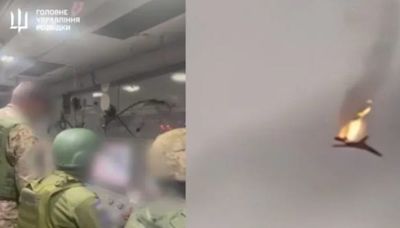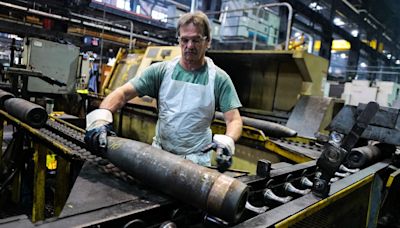Search results
Russia, or the Russian Federation, is a country spanning Eastern Europe and North Asia. It is the largest country in the world by area, extending across eleven time zones and sharing land borders with fourteen countries. It is the world's ninth-most populous country and Europe's most populous country.
- Coat of Arms
The coat of arms of Russia derives from the earlier coat of...
- Demographics of Russia
Obesity is a prevalent health issue in Russia; 61.1% of...
- Republics
The republics are one type of federal subject of the Russian...
- Federation Council
Federation Council Building in 2017. The Federation Council,...
- Annexation of Four Ukrainian Regions
Date: 30 September 2022; 16 months ago (): Location:...
- Tsardom of Russia
The Tsardom of Russia, also known as the Tsardom of Muscovy,...
- Orthographic Projection
You are free: to share – to copy, distribute and transmit...
- History of Russia
The history of Russia begins with the histories of the East...
- Flag of Russia.svg
The uploader or another editor requests that a local copy of...
- Coat of Arms
Russia, or the Russian Federation, is a country spanning Eastern Europe and North Asia. It is the largest country in the world by area, extending across eleven time zones and sharing land borders with fourteen countries. It is the world's ninth-most populous country and Europe's most populous country.
- Global Position and Boundaries
- Administrative and Territorial Divisions
- Human Geography
- Physiography and Hydrography
- Agriculture Geography
- Area and Boundaries
- Natural Resources and Land Use
- Natural Hazards
- References
Kaliningrad Oblast, westernmost part of Russia along the Baltic Sea, is about 9,000 km (5,600 mi) apart from its easternmost part, Big Diomede Island in the Bering Strait. This distance spans about 6,800 kilometres (4,200 mi), to Nome, Alaska.[clarification needed] From north to south, the country ranges from the northern tip of the Russian Arctic ...
With a few changes of status, most of the Soviet Union's administrative and territorial divisions of the Russian Republic were retained in constituting the Russian Federation. As of 2014, there were eighty-five administrative territorial divisions (called federal subjects): twenty-two republics, nine krais (territories), forty-six oblasts (province...
Demographics
Russia had a population of 142.8 million according to the 2010 census, which rose to 146.2 million as of 2021 following the annexation of Crimea in 2014. It is the most populous country in Europe, and the ninth-most populous country in the world; with a population densityof 9 inhabitants per square kilometre (23 inhabitants/sq mi).
Urban areas
1. Moscow, the capital and largest city of Russia 2. Saint Petersburg, the cultural capital and the second-largest city 3. Yekaterinburg, the fourth-largest city in the country. Russia is one of the world's most urbanized countries, with roughly 75% of its total population living in urban areas. Moscow, the capital and largest city, has a population estimated at 12.4 million residents within the city limits, while over 17 million residents in the urban area, and over 20 million residents in t...
Geographers traditionally divide the vast territory of Russia into five natural zones: the tundra zone; the Taiga, or forest, zone; the steppe, or plains, zone; the arid zone; and the mountain zone. Most of Russia consists of two plains (the East European Plain and the West Siberian Plain), three lowlands (the North Siberian, the Central Yakutian a...
One billion acres of land is arable in Russia, but only about 0.1 percent is permanent agriculture.The landscapes of region have extremely varied environments because of the following: 1. Tundra landscapes cover most of the region, where conditions are harsh because of the cold climates, and plant life is not very well supported to grow because of ...
Area (excluding Crimea): 1. Total: 17,098,242 km2 2. Land: 17,021,900 km2 3. Water: 79,400 km2 Area - comparative: Slightly larger than twice the size of Brazil Land boundaries: 1. Total (excluding Crimea): 19,917 km Kaliningradforms the westernmost part of Russia, having no land connection to the rest of the country. It is bounded by Poland, Lithu...
Russia holds the greatest reserves of mineral resources of any country in the world. Though they are abundant, they are in remote areas with extreme climates, making them expensive to mine. The country is the most abundant in mineral fuels. It may hold as much as half of the world's coal reserves and even larger reserves of petroleum. Deposits of c...
Volcanic activity in the Kuril Islands and volcanoes and earthquakes on the Kamchatka Peninsulaare other natural hazards.
This article incorporates text from this source, which is in the public domain. Russia: A Country Study. Federal Research Division.This article incorporates public domain material from The World Factbook. CIA.- Mount Elbrus, 5,642 m (18,510 ft)
- Caspian Sea, −28 m (−92 ft)
- Lake Baikal, 31,722 km² (12,248 sq mi)
Russia (Russian: Россия, romanized: Rossiya, [rɐˈsʲijə]), or the Russian Federation, is a country in Eastern Europe and North Asia. It has land from the Baltic Sea to the Bering Strait . It is the largest country in the world , followed by Canada , the United States , and China .
3 days ago · Russia, country that stretches over a vast expanse of eastern Europe and northern Asia. Once the preeminent republic of the U.S.S.R., Russia became an independent country after the dissolution of the Soviet Union in December 1991. The capital of Russia is Moscow.
The history of Russia begins with the East Slavs, Turkic, and the Finno-Ugric peoples. [1] [2] [3] [4] Parts of Southern Russia around the Black sea were settled by Greeks and Romans until about the 3rd century. Huns and Turkic tribes invaded the regions around the Black sea until the 10th century.






